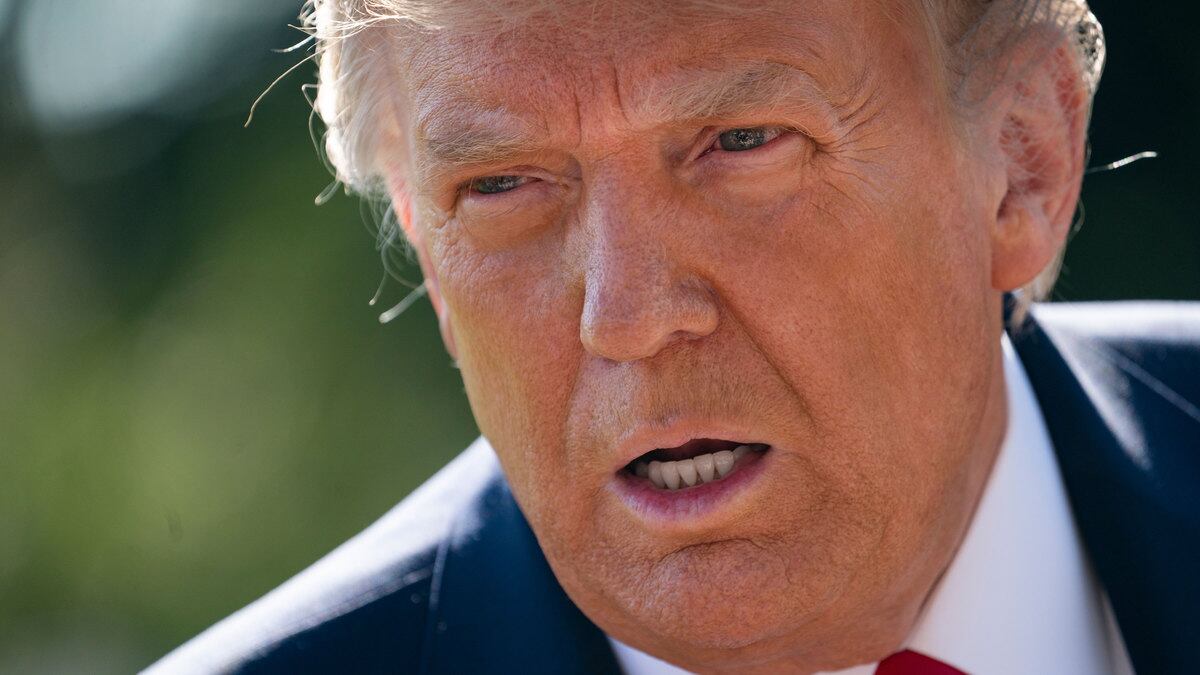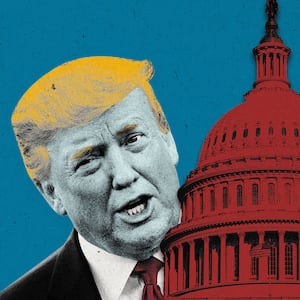Hitting the closing stretch of the election, and trailing by a substantial margin in the polls, Donald Trump is placing his political hopes on winning over voters with cold, hard cash.
Over the past month, the president and his team have coalesced around a series of policies that would result in billions of dollars being allocated to critical constituencies right as voting begins: a proposal to dramatically increase government lending in African American communities, an order to send seniors a $200 rebate card for prescription drug purchases, and a newfound desire for an ambitious stimulus package to deal with the fallout for COVID-19.
Critics view the tranche of ideas as tantamount to government-sanctioned voter buy-offs. Fiscal conservatives have privately bristled. But the president sees them as, perhaps, his last electoral panacea. The only question is, can he get the money out fast enough?
“It’s smart policy and smart politics,” said one senior Trump campaign adviser. The goal, the adviser added, was to reassert a frame that worked well in 2016: “One side views you as the forgotten man and forgotten woman worth fighting for, and the other side views you as deplorable and irredeemable.”
Trump’s frantic dash to get money into the hands of critical constituencies comes amid the backdrop of a campaign struggling for any political momentum at all. What’s surprised some observers is not that Trump’s now trying to spend his way out of that hole and into a second term, but that it took him this long to start doing so in the first place.
“It's a real head scratcher, and one we'll look back on as a huge mistake,” said GOP strategist Liam Donovan. “I think embracing the populist (and popular) part of the vision he was elected on could have mattered, but we're well past the point where these desperation heaves can change the trajectory of the race.”
Back in 2016, Trump ran for the presidency as an unorthodox Republican, one keen on reminding voters that he wanted to protect entitlement programs, revamp free trade deals, and spend copious sums on things like infrastructure. The recipe worked, barely. And for a while, Democrats scrambled to adjust to the possibility that the Republican Party had claimed the mantle of working-class populism.
But that panic began to fade as Trump began to govern, choosing to pursue Obamacare repeal, massive tax cuts, and a deregulatory agenda over things like infrastructure investments and lowering prescription drug prices. Looking back now, some Democrats can’t believe their luck.
“In terms of how he has governed, he has been a traditional, down the line, fiscal conservative on pretty much every issue,” said Rep. Brendan Boyle (D-PA). “No question about it. If he had really governed in an economically populist way, I think he would have been in a stronger position.”
But the problem facing Trump, sources around his campaign have conceded, is not just that his governing agenda didn’t match his populist promises, it’s that his re-election campaign messaging abandoned those promises too. His opponent, former Vice President Joe Biden, has many of the same vulnerabilities that Hillary Clinton had in 2016. Biden voted for major trade deals that Trump has argued led to the ruin of the rust belt. And Biden’s close ties to the credit card industry have provided grist for past opponents to accuse him of siding with corporate interests over consumers.
And yet, Trump has largely focused his attention elsewhere. Data put together by the firm Bully Pulpit Interactive tells the story of a re-election campaign leaning far more heavily on conspiracy theories and culture war issues than messages of economic recovery and relief. The Trump campaign has spent more than ten times as much on ads mentioning or pertaining to “far left/Antifa” of late than it has on ads concerning the economy, and more than 35 times as much as it has on ads mentioning trade, a signature Trump issue, according to that Bully Pulpit data.
From September 12 through October 3, the Trump campaign spent about $3,5 million on ads invoking terms such as “socialism,” “fake news,” and “Clinton,” compared to less than $130,000 on ads concerning the U.S. economy, about $400,000 on ones mentioning small businesses, and just $42,500 on those mentioning “trade.”
Last week, that drifting focus and those competing impulses were apparent once more, as Trump declared he was abandoning efforts to negotiate a new coronavirus relief deal with congressional Democrats only to do an abrupt 180.
For months, several conservative Trump allies had been getting in the president’s ear, trying to convince him to nuke the stimulus talks and finally abandon any vestiges of his right-wing economic populism.
On Tuesday, shortly after Trump had tweeted that he was blowing up the negotiations, Stephen Moore, a longtime conservative economist and an informal adviser to Trump, said he and his colleagues were pleased by the news, and that they had long counseled the president that further stimulus packages would be “counterproductive.” Moore added that he’d met with Trump last month at the White House and advised him that following through on negotiations with Democratic leaders would be, in his view, economically disastrous, as well as politically unwise, as any significant stimulus-related boost wouldn’t register with voters before the November election.
At the same time, some populist-oriented conservatives were aghast that the president would forgo an opportunity to give Americans a financial lifeline in the midst of high unemployment and a deadly pandemic, especially one that came right before they head to the polls.
Trump occasionally flirted with doing direct stimulus payments. But he never engaged on a bill. His chief objection to Democrats’ legislative demands was efforts to include large chunks of money for state governments that could help alleviate budget shortfalls and boost their own economies amid a crippling recession. “They just wanted to take care of Democrat failed, high crime, Cities and States,” the president griped of his opponents’ demands.
It was a complaint that dovetailed with a larger theme of Trump’s election-year messaging: that rising levels of violent crime, racial unrest and occasionally violent demonstrations against police misconduct, and high coronavirus infection rates are all problems that Democratic mayors and governors around the country have created. But for Democrats it was dumbfounding. They were handing him a huge check to spend on voters and he was declining.
“The irony here,” said Guy Cecil, who leads the Democratic super PAC Priorities USA, is “if Republicans would come up to [House Speaker] Nancy Pelosi's number [for a large stimulus bill] it would actually help the president politically, not Democrats.”
By week’s end, Trump seemed to have grasped that point. He began asking for stand-alone bills to bail out specific industries. By Friday morning, he had authorized support for a $1.8 trillion deal—within the ballpark of what House Democrats were demanding, though without specificity on what provisions he’d support. By early afternoon, he was claiming he wanted even more.
"I would like to see a bigger stimulus package frankly than either the Democrats or Republicans are offering,” he told Rush Limbaugh. But his own White House soon contradicted that claim. They would agree to up to $2 trillion, a spokesperson said—less than the $2.2 trillion Democrats sought.
And therein lies part of the problem. While Trump may now want those checks, it’s unclear if the rest of his administration or party does. Senate Republicans appear disinclined to support a stimulus package that will match the one that the president is now abruptly pitching with bravado. And House Democrats continue to oppose the specifics of what the administration is asking for, saying it doesn’t do enough to deal with the fundamental problems caused by the COVID crisis.
And even if it all gets done before the election, it may not be enough to salvage Trump’s campaign. An 11tth hour check, critics argue, can’t wipe away the last four years.
“His rhetoric has stayed semi-populist when he could squeeze it in between the traditional supply side economic, normal Republican big business approach he took. It’s hard to do both,” said Rep. Tim Ryan (D-OH). “Part of it is, he doesn’t have a leg to stand on. The trade deficit is up, jobs have been outsourced, the plants are closed. So there isn’t a lot to be populist about, at least rhetorically.”




